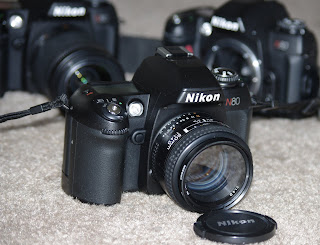Here I will not really write a review on N80, I will put my images of N80 below and let you view. What I should say is, I am neither a fan of any camera brand nor of any camera model. I just like to use different slr cameras like my 2 and 3 years old sons who alway hold small cars in their hands. However, I do own several N80s. Here are some of them. Any complaint about N80? Yes, I have one below the images.
Nikon N80 also has a QD version that can imprint date/time onto film. The QD back does not require a separate battery to power the clock. The backs were not designed for quick change. A screw driver and skill are needed when taking-off and installation of the backs on N80. With some study and info, I changed the backs myself.
The focusing screens in Nikon N80 is not interchangeable, as Nikon website says. In most bodies, the screens have no marks, 5 focus brackets and a reference circle of center-weighted metering will show up once with battery power. Grid Lines can be superimposed onto the focus screen with the camera's Custom Setting #4. I did saw that two N80 bodies (SN 2806895 and 2806904) had a horizontal line physically marked on their focus screens. They are rare and not likely a custom add-on.
If you want to attach a AA-battery grip MB-16, you need to take off the battery door at the bottom of camera. When I first did it, I thought I would break the door or its attachment, but it would be ok since I have done many times. Why is there no better design? Like in N65 and MB-17, which has a chamber to accept the opened battery door still attaching to the camera bottom.
Nikon also produced two models of semi-soft cases for N80, CF59 and CF60. The later is for a N80 with a long zoom lens.
Nikon F80S is different from its siblings by imprinting the shooting data (spreed, aperture and exp compensation) vertically on the frame between two photos. For this function, F80S has an extra Custom Setting (CSM) 19 as 'ISO film speed setting for data imprint between frames'. F80S sets the film speed automatically, but it can be changed manually in CSM 19. And there is a selector on the data back of F80s to choose if the shooting data are printed or not.
 |
| The data back on Nikon F80S |
 |
| Like N80 QD and F80D, the F80s sign is not marked on the camera body, it is printed only on the package box and the manual for F80, F80D and F80S. |








The design of N80 was so good that Kodak decided to convert it into Kodak's Professional digital SLR DCS-14n, which was released Sept., 2002. Interestingly, I saw a lot of 12 unfinished N80 bodies on ebay (Item number: 280773033473 in Nov, 2011), which says 'This is an interesting lot! 12 Nikon N80 camera bodies that were shipped partially completed to Eastman Kodak to be made into full frame digital bodies, DCS 14n cameras.'
ReplyDeleteMore info can be found at http://www.dpreview.com/reviews/kodakdcs14n/
Fujifilm also used N80 body to convert their DSLR Finepix S2 or S3 Pro during 2002 - 2007.
ReplyDelete